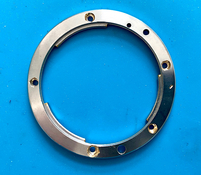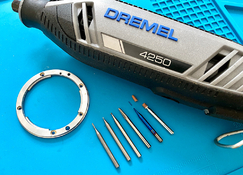Think about mounting the Dremel in a fixed position and bring the work to the cutter, Andreas. Sometimes this can make for a more stable way to work.
Some of this is along the lines of whether we should modify equipment for our needs or not. The way you are working is not going to give the most finished or proper solutions. But you can still get a solution of some sort and move on to getting a camera working again. Like the lens mount plate you showed- pretty crude, but it will get you where you want to be. But I'm the kind of person who was given a nice Olympus OM system lens that had a major ding in the filter threads. After some consideration, I decided to simply grind away the bent part of the threads- there was still 3/4 diameter of clean threads and all worked well! Yes, I am a heathen...
I did product prototyping for many years and learned to do things with rotary cutters like a Dremel that no one would suggest you do. Making engineering spec models to tight tolerances with a Dremel is a lost art

Well, Foredom tool, actually, much less gyroscopic forces to fight with the hand as the motor is a meter away. Worth a consideration and breaks down fairly tight.
Foredom rotary tools & flexible shaft machines are built to industrial standards and are known for quality and reliability. Foredom is synonymous with Flexible Shaft Machine for many people. Flex shafts are used for many jobs including grinding, deburring, carving, engraving, stone setting, and...
www.foredom.net
Not sure what Dremel you have. Not too long ago I had burnt out yet another and the store only had the more expensive model in stock. So I got it, and will never look back. I don't know the terms, but it has a motor that adjusts for loads. In other words, maintains a constant speed in cutting, not slow down in reaction to cutting and pressure. Wonderful feature. Not sure how they are marketed in Europe, but it is the 4000 model here with the electronic speed control. Well worth getting if you can or don't have it yet (having a couple of Dremels is a good thing, keeping them set up with different tools rather than swapping all the time)
/

www.dremel.com
There are times and objects where proper tools and setup are the only way to go. Keep learning about the proper ways and work towards it, and in the meantime do what you can on the more mundane objects, eh?
On something like the lens mopunt earlier in this thread, those are decent sized screws. If the surrounding material is also metal, you have a huge heat sink pulling away any applied heat on the screw. Any soldering iron that is useful for working on camera electronics is not going to produce enough heat on screws like that. Small pin-point blow torch is the best cheap way to get enough heat on it. Of course also the best way to melt other parts, start a fire, etc.








 Well, Foredom tool, actually, much less gyroscopic forces to fight with the hand as the motor is a meter away. Worth a consideration and breaks down fairly tight.
Well, Foredom tool, actually, much less gyroscopic forces to fight with the hand as the motor is a meter away. Worth a consideration and breaks down fairly tight.















